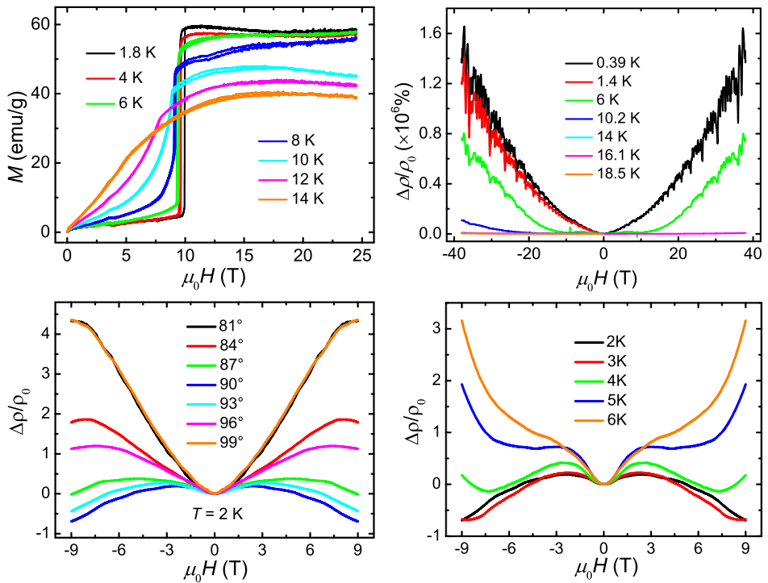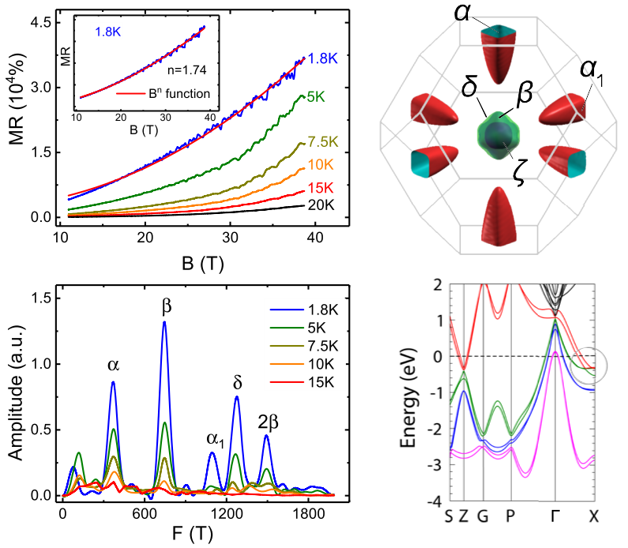Nov 02,2018|By
Recently, a joint research group from the High Magnetic Field Laboratory, Chinese Academy of Sciences (CHMFL) demonstrated the existence of topological semimetal states in magnetic monopnictides, namely, NdSb and DySb.
The three-dimensional (3D) topological semimetal states in condensed matters possess the linearly dispersing low-energy excitations that are similar to the fundamental particles (Dirac or Weyl fermions), which not only provides a fascinating bridge between high-energy and condensed-matter physics, but also serves as an ideal platform to investigate spontaneous symmetry breaking, phase transition, and many other fundamental phenomena in nature.
In 3D topological Dirac semimetals, the Dirac points are protected by both time-reversal symmetry and crystalline inversion symmetry, viewed as the 3D-analogue of graphene.
When inversion or time-reversal symmetry is broken, the Dirac point may split into pairs of Weyl points and the Dirac semimetal becomes a Weyl semimetal. While the Weyl semimetals that lack inversion symmetry have been confirmed in TaAs and WTe2systems, the Weyl semimetal state with time-reversal symmetry breaking has not been found for a long time, due to the magnetism induced by the broken time-reversal symmetry.
The angle-resolved photoemission spectroscopy (ARPES), used to be a powerful probe to unveil the electronic structures of non-magnetic materials, is greatly limited for the study of magnetic materials in magnetic ordered state.
Nevertheless, it is theoretically predicted that the magnetic topological semimetal state might exist in the rare earth monopnictides (antimonides or bismuthides), GdPtBi and Mn3Sn, etc.
In this study, the researchers performed detailed magnetic and transport measurements under high magnetic fields (up to 40 Teslas).
They studied the magnetic structure transitions caused by the high magnetic field, and analyzed the extremely large magneto resistance and quantum oscillations revealed in transport measurements, for the different magnetic states of the compounds.
In combination with the first-principles calculations, the antiferromagnetic state of NdSb is proved to be a Dirac semimetal state, and the ferromagnetic state of DySb is a Weyl semimetal state.
Especially, the observation of chiral-anomaly-induced negative magneto resistance provides fingerprint evidence for the existence of topological semimetal state. Moreover, the tunable magnetic structures make NdSb and DySb an ideal system to investigate the correlations between magnetism and topological properties.
The researchers used the facility of CHMFL at Hefei, including the Cell-1 and Cell-2 resistive magnets and the hybrid magnet.
This work was supported by the National Key R&D Program of China and the National Natural Science Foundation of China.
 |
|
High-field magnetization and magnetoresistance for NdSb(upper panels) and negative magnetoresistance taken at various angles and temperatures(lower panels). (Image by WANG Yongjian) |
 |
|
High-field magnetoresistance and quantum oscillations for DySb (left panels), and the calculated Fermi surface and band structures (right panels). (Image by LIANG Dandan) |
Attachments Download: